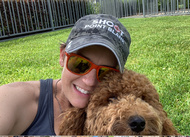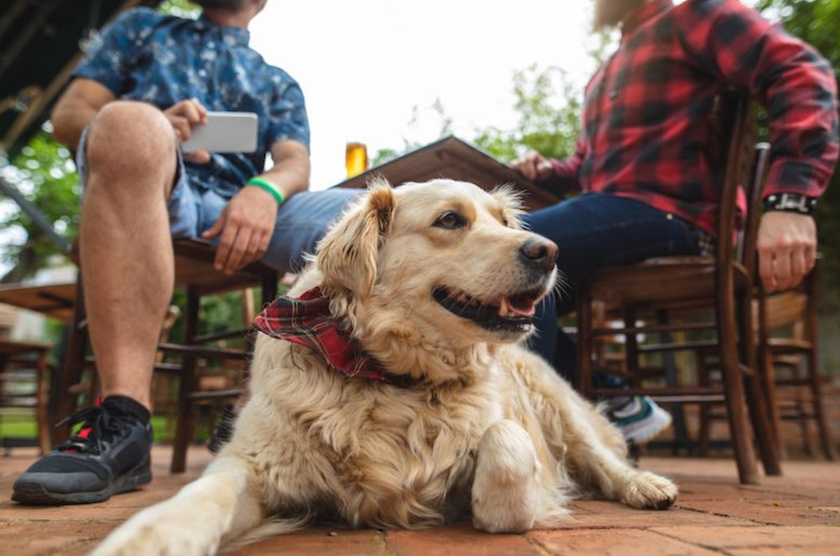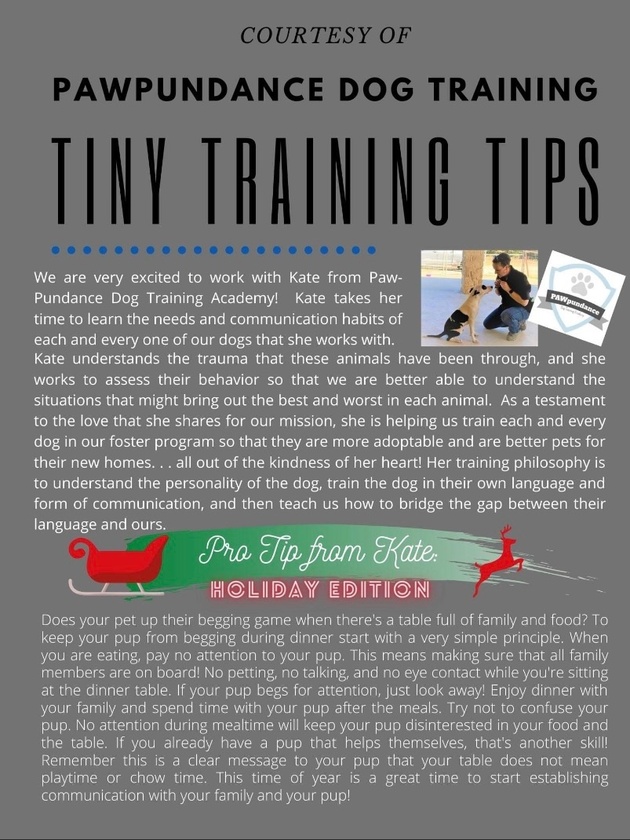
It’s ok! We’re here to help. We speak a little dog and can help translate for both of you. It’s probably just a miscommunication! And we are here to help get you both speaking the same language! Woof!
Connect with the PAWpundance training team and other members of the dog community to discuss better ways to communicate with your furry house guest.
**To get started USE code: TRIAL1month **
Distance Cues
"Only the person I'm standing next to has food..." - your pup. Or I can teach you to give a cue from any where.
Distance cues have become really popular lately. What are they? Just like they sound. Being able to ask your dog to perform a behavior while they are standing away from you (example: 10ft, 20ft, 60ft) is a distance cue. Specifically the down cue is popular. Most people think they have taught their dog to sit, but then when they are across the dog park or living room the dog doesn't respond. They never taught the dog to respond to a sit when the dog wasn't right beside them. So everyone has seen the human shouting the cues and the dog is staring and the person in front of them waiting for a cue. They ignore everyone except the person standing in front of them. That's where the treats have always come from. So now we teach them that, "I will tell you something from way over here and you can still get a treat." Stop shouting across the room. Start training it.
Why is this so popular? It's not just some fancy one-up trick to show off. It's a great safety tool to help communicate with your pup. If your pup is engaged and focused, with a distance down you can ask for calm behavior without asking for your pup to disconnect. To ask for a recall, the dog has to completely disconnect and lose focus and turn their back on whatever has sparked their interest and come to you. With a distance down, you are just ask the pup to go relax their physical stature but they can stay mentally engaged. It shows that they are still able to respond to you and you have a good relationship. You understand your pup is concerned about something or is just very interested in something. If it's a fear related issue, it's not even fair to ask your dog to turn their back to come to you. If it's a true fear, it becomes like a panic attack. In these cases, being able to ask for calm behavior but not forcing your dog to turn away is huge.
So the dogs that benefit from this type of training are going to be reactive dogs. Learning to have this skill is helpful. When working on behavior modification, we are mostly right there next to the pup. Being able to start having distance from the pup and still being able to ask for calm behavior is really great. Big pups, even if they are gentle giants benefit from this skill. There will always be someone afraid of the nicest pup... just because of their size. But if you can ask for a down from across the room then it shows the big pup has more impulse control and more communication with you. It's less scary for someone scared of big dogs. All dogs would benefit from learning distance cues. It's following through on training. However reactive pups, dogs needing impulse control and big pups are the dogs that I would say MUST learn this skill.
How do we accomplish a distance skill? Obviously you need to have foundational skills with your pup. We begin every training with 5 Basic skills: Sit, Down, Stay (impulse control for pup, instructional control for human), Recall (come), Loose Leash walking. We do an evaluation, give certificates and have a small celebration of achievement. We are looking for what Karen Pryor in Don't Shoot the Dog! calls "Stimulus Control". (Find more info on page 73)
1. The pup responds to the cue when given
2. The pup doesn't "throw" the behavior in when you haven't said the cue
3. The pup doesn't mix up cues and behavior - You say A and get B
4. The pup doesn't mix up cues and behavior - You say A and get ANY thing else or nothing.
When you pup and do the basics or foundations and it's clear that it's understood, then it's time to start working these skills with distance.
I like to have a verbal and a physical cue for both. While dogs obviously respond to physical gestures and body language better than words, we still teach the verbal cues. (I have never seen dogs having a conversation in the wild, it's obvious they "read" each other through physical communication. A recent scientific article proved physical cues were easier than verbal. Um yeah. We teach both to challenge them and to have the cue in case we can't see them.)
Grab a leash and tether your pup. The best principle is to control the environment and set the pup up for success rather than try to control a behavior. So I like to have your pup sitting on a pillow so there is no tension on the leash. Ask for a sit so the pup is still sitting on the pillow. Do this a couple times with NO tension on the leash. Once you have established a couple wins, take a small step back. Now lean over a bit so your head and hands are still near the pillow and ask for a sit. Do a couple more and see if you can keep slack on the leash and your pup on the pillow. Slowly start to stand up more and start working on puppy push ups if you pup is doing good. Every time you move back a little with you feet, let you top trail a little. It works like ...?... and you just slowly just move away. As soon as you see licking, itching, twitching, looking away or you have a big milestone - call it. End your session and pick it up again next time.
The progression will be the same every time. We have the leash to train us to react to any tension and to keep the pup from running around. The leash won't train the pup, it will keep the focus of the session so we aren't having to constantly recall and confuse the topics. But don't think the leash is communicating anything to your pup. It's for you to learn to see when your pup is starting to move and you need to react. Once you can move a step or two away, then do push ups: sit and down. Then start moving the pillow and tether to different locations around your home. If you can, once you have more consistency, remove the tether. Continue to move the pillow until consistent then try with a blanket or different bed/pillow. Then try without anything. Once you can do push-ups a step or two away from the pup, congrats! This is a huge accomplishment.
You can try to add distance with out the tether or pillow, but if it doesn't work, go back to the beginning. If you ever struggle, go back to the beginning. Go to the same spot, tether, pillow and start close. Add the first step and give WIN!! And another step! Win! As soon as you get the next step maybe you can get 3 or 5 steps, then do the whole thing over again. It will go FAST this time. Every iteration is going to go twice as fast as the last time. But if you always have the discipline to go back to the beginning and run it like a system or routine, you will not have a linear progression - you will have exponential growth. It will happen so fast.
Now that you have 5 steps you can add one more step to the end of your routine, bring a friend and try it out in the park! The benefit of a friend is they can help balance the tension on the leash. You can bring the pillow/blanket outside and work in the park. When we work this type of skill we strive for the principle progression of: Duration, Distractions, Distance. So before you add another step, ask, "can we add some time? Add a stay? Can we add distractions? Is there anything we can do to make this iteration a bit more solid or 'stimulus control'?" As soon as you have a complete iteration, add distance.
As soon as you have a pup that can respond consistently to 30 feet or so, start to change the "view". Meaning ask for a distance down when the cue is given by a human who is out of sight. So there might be a time where the dog is far away and they can hear you but not see you. You can see them, they can't see you. "It's ok. Just go down until I can get to you."
After we get this far, we start working behavior chains. Basically we have routines: Sit, Stay, Distance Down, Back up into a distance Sit, etc. And this is kind of fun! The dogs start to learn the routine. We teach them in reverse order so the end up going very fast and fun.
There are lots of random opportunities to do these skills. We like having our dogs out of the kitchen, especially while we cook. Thus we ask for a stop cue before they cross the threshold of the kitchen. If we are cooking something yummy they just want to get some smells so we can ask for a down without even leaving cooking. Our dogs will lay down at the threshold of our kitchen and watch us cook, smelling all the delicious smells. Distance cues are also great for the dog park. Being able to break up a dog interlude with a distance cue is helpful. If your dog seems to be struggling to not engage with another dog, ask for a distance down. It doesn't require your pup to disengage, but it tells the other pup that your dog is a calm pup. And you pup is still able to protect himself if the other dog becomes aggressive, he doesn't have to give up his back (jujitsu jokes). Having a solid "come" is really important as well. But this might give your pup a moment to calm himself so he can come to you on his first try!! It's not to work against your recall/come cue, it's to work with it and make it stronger.
In the end, teaching sit/down etc, is just a start. To complete the understanding of exercise, you want to be able to say/gesture from where ever and your dog look at you and respond. Most of our dogs only understand that the person they are standing next to has the food. Finish it. Teach a distance down!
Welcome to PAWpundance Dog Training Academy on Locals.com!
We’re thrilled that you’ve joined our community! PAWpundance is a place for positive, dog-loving people to come together, share experiences, and help each other grow. Locals offers an “ad-free experience,” so even a small contribution helps support our tech and keeps our community thriving.
We want to see your furbabies!
We’re here to assist with any questions you may have about training, behavior, and more. At PAWpundance, we believe in blending knowledge with a bit of fun—expect plenty of paws, puns, and maybe even a dance or two! Together, let’s enjoy some laughs and build stronger relationships with our pups.
Our Philosophy:
We’ve invited another species to live in our homes, and our dogs are much more than accessories; they’re our guests. They don’t speak our language, and like in the movie E.T., we don’t want to be the intimidating figures trying to coerce a scared, confused being. Instead, we want to be like ...
Eye Contact, Eye Contact, Eye Contact!
Reward every glance. Start by reinforcing brief glances, then encourage your pup to hold your gaze a bit longer. Gradually phase out your part of the eye contact—your pup will learn to watch you and adapt to your movements naturally. This approach helps them learn to walk with you without relying on leash cues.
Remember, the leash is purely for safety—not for communication.
Take a look at this video with Meghan and Buckee. Buckee is watching Meghan closely, and she rewards him by making eye contact, smiling, and offering treats. Meghan also looks forward occasionally, teaching Buckee to walk with her in sync.
Notice that Buckee is a reactive pup, so the leash is essential for safety, especially if he responds to something unexpectedly. However, it’s only used for physical control when necessary. When Buckee refocuses, Meghan reestablishes instructional control, and they continue their walk together. She does a fantastic job of engaging with him! In ...
Loose-Leash Walking Tip:
Where you reward makes a big difference! Try using the hand on the same side as your dog when giving treats or praise.
When you reach across your body to reward with the opposite hand, it draws your dog’s nose in front of you, encouraging them to move ahead and potentially start pulling.
In the video of Meghan and Domino, Meghan holds the leash with her left hand while Domino walks on her right. She rewards him by petting and giving treats with her right hand. This keeps Domino walking by her side on a loose leash, rather than in front, pulling her along.
Next time you’re out walking with your pup, try rewarding with the hand on the same side as your dog.
https://twitter.com/wholedogjournal/status/1295508215740932098?s=21
How to teach you pup to be a good dining companion! What a great skill!

https://twitter.com/wholedogjournal/status/1292609106637987840?s=21
This is about counter-surfers, but I love the description of trying to shame dogs. This author, Pat Miller helped me understand this concept in her book the Power of Positive Dog Training.
If you’re still on Twitter, the Whole Dog Journal is a great group to follow. Lots of fantastic info!













